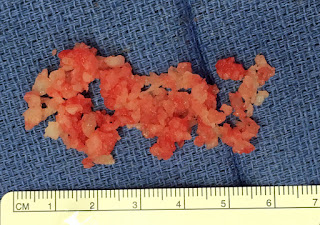Multiple enchondromatosis is also known as Olliers Disease. In this disease, at least 2 cartilage tumors known as enchondromas grow in different bones. Initially, we tend to watch the growths, but sometimes surgery is necessary. I have previously blogged about Olliers as part of a post on MACRODACTYLY. There are number of sites that provide good, basic information on Olliers Disease including Wikipedia, NORD, and OMIM. The NORD site is perhaps the best.
The enchondromas in Olliers Disease are typically benign, meaning that they don’t spread and are not malignant. There is a risk, however, of transformation to “bad” cartilage tumors such as chondrosarcoma. This is the reason that we keep a close eye on these tumors. A related disease, Maffucci Syndrome, also has enchondromas but includes blood vessel growths called hemangiomas. This can have a higher rate of malignancy.
The indications for surgery include pain, deformity (such as angling of the bone), or a break in the bone. The reason problems develop is that the cartilage tumors can expand the bone and make it weak- this weakness can lead to a fracture. In addition, the growing tumor can affect the growth plate leading to angulation of the bone. It is interesting that adults can also develop these tumors but in these situation in adults, only 1 enchondroma appears.
It takes several years at least for evidence of the enchondromas to appear in the child. Sometimes the first sign is a broken bone through the weak area and sometimes the first sign is angulation of the bone. If we believe that a child has Olliers, we perform a skeletal survey- that is we xray multiple different body areas. Typically Olliers only affects one side of the body.
Here is one child with pain and deformity related to the enchondroma growths. There are 3 growths in this child, 1 in the thumb and 2 in the index finger.
 |
| Olliers Disease. Note the swelling of the index finger. That is the expanded bone. |
 |
| Another view of Olliers Disease in the hand. |
 |
| Olliers Disease. Note the disease in 2 bones of the index finger and 1 bone of the thumb. |
In this child, due to pain and enlargement, some deformity, and decreased motion, we performed surgery to remove the cartilage tumor. We filled the “holes” with bone graft. This should heal over time.
 |
| Enchondroma as removed from the index finger. This is soft cartilage growth. |
My Bio at Washington University
congenitalhand@wudosis.wustl.edu
Wonderful illustrated information. I thank you about that. No doubt it will be very useful for my future projects. Would like to see some other posts on the same subject! Dr. HE Schlauchmagen Op Türkei